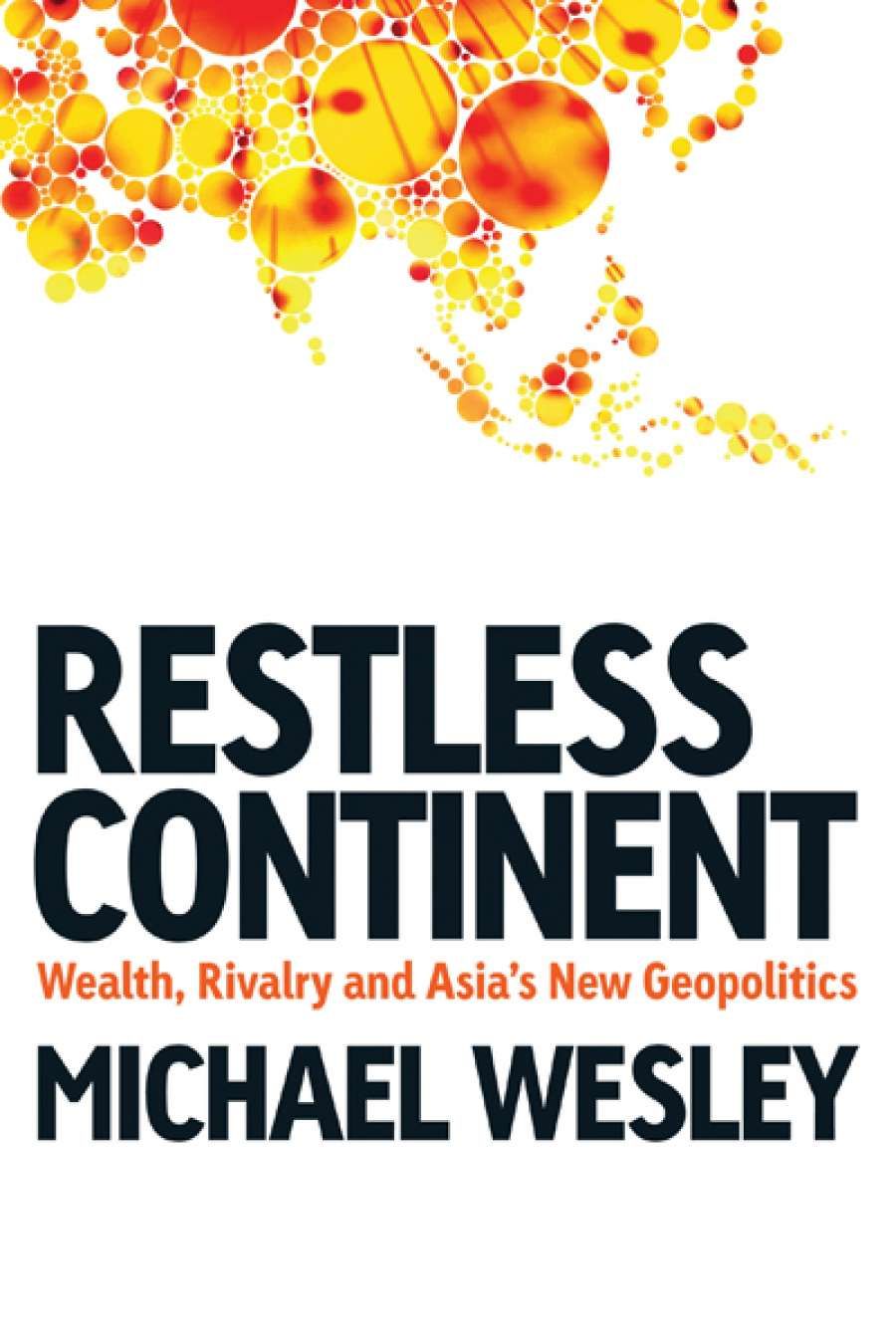
- Free Article: No
- Contents Category: Politics
- Custom Article Title: Finian Cullity reviews 'Restless Continent' by Michael Wesley
- Review Article: Yes
- Online Only: No
- Custom Highlight Text:
Australia does not have a great tradition of writers producing books on international affairs for a general audience. Along with others like Hugh White, Michael Wesley – a former head of the Lowy Institute now based at the Australian National University – is helping to correct this.
Economic interdependence has largely been a good news story. Colonialism saw the 'distortion of Asia's economies ... and the withering of trade between Asia's societies'. The region's recent economic success, by contrast, owes a lot to the spread of intra-Asian production-chain networks – a development which itself has fostered more interdependence (not to mention growth) by increasing demand for energy and infrastructure investment.
Things are, however, not all rosy for those on the inside. Traditionally, authoritarian governments in Asia, predisposed to shielding themselves from outside influences in order to maintain order and control, have been shocked by the extraordinarily rapid pace of development. Urbanisation, for instance, has wrought social upheaval, with subsistence living giving way to jobs provided by that embodiment of economic interdependence: the market. These governments know that their very survival depends on the continuing economic vitality of their citizens. They worry about things like the 'middle income trap' or their dependence on energy imports, and baulk at signs of a global system weighted against them, such as when a financial world tied to the US dollar is destabilised by quantitative easing.
This 'outsider mentality', as Wesley notes, is related to the cultural importance of hierarchy in many Asian countries. Notions of status, oftentimes embedded in Asian languages themselves, are just as important for domestic social relations as they are for international relations. History has only accentuated the importance of hierarchy: Asian nations previously subjugated by European colonisers, or integrated into a tributary system with China at its cultural and economic apex, are understandably sensitive to what they perceive to be slights.
'Economic interdependence has largely been a good news story'
Indeed, prickly responses to events thought to call smaller countries' independence or national pride into question have been on frequent display recently. Wesley mentions the extremely angry popular response by South Koreans to UNESCO referring to Koguryo – an ancient kingdom considered by Koreans to be a significant part of their heritage – as a 'kingdom of China'. One could refer to a number of other flare-ups as well, such as the violent protests in Vietnam following China's placement of an oil rig in the South China Sea in 2014.
 Michael Wesley
Michael Wesley
Wesley also identifies the importance of China's rise for what he calls the 'structure of latent force' – in other words, the distribution of military power that helps define what is and is not possible in international relations. This is in turn shaped by geography. Wesley points to a maritime arms race in Asia's 'southern tier' (extending from the Persian Gulf all the way around to the Korean Peninsula) fed by relatively cheap maritime defence technology and heightened territorial competitiveness. He also explains the strategic significance of bays and peninsulas for Asian giants dependent on seaborne trade, and the role that Central Asia might play should historical competition between China and Russia flare again.
Restless Continent succinctly and persuasively describes the transformation in economics and geopolitics underway in Asia. It serves as a healthy reminder that this is not just a story about the United States and China. But, like everything, it is not without flaws. One is occasional clumsy expression. References to such things as 'harried tendrils' of smoke and a 'landlocked archipelago of smaller states' in Central Asia are distracting. So is talk of the 'necessary conditions of Asia's peace and prosperity' being 'provided by three interlocking pillars'. The more academic writing style of the final chapter also sits at odds with the rest of the book, and detracts from some of that chapter's interesting ideas, such as the improbability of an 'air-clearing' war.
'Restless Continent succinctly and persuasively describes the transformation in economics and geopolitics underway in Asia'
More generally, while Wesley's argument that Asia must be conceptualised as a whole – not simply as South Asia, Northeast Asia, and the like – is mostly convincing, it is not sufficiently explained. For example, while the importance of oil means it makes sense in strategic and economic terms to think of the Middle East as belonging to the same Asia as the one inhabited by China and India, it is unclear whether this works when discussing, say, the influence of hierarchy on the rivalry between Asia's states.
Nevertheless, Restless Continent is a satisfying read for anyone interested in working out what that slogan, the 'rise of Asia', really means.


Comments powered by CComment